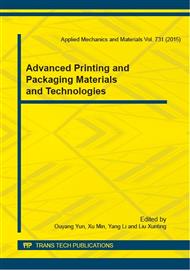p.183
p.187
p.193
p.197
p.201
p.205
p.210
p.214
p.218
Extracting Golden Area from Image Based on Canny Operator
Abstract:
This paper researched application of Canny algorithm on the color separation of golden image , to generate a separated golden image plate base on the extraction of golden area, so as to get the effect more closer to the real metallic. Canny algorithm is based on the gray-scale image segmentation algorithm. The image is mapped from RGB to Lab color space. According to the color attributes of b, the golden target regions are extracted using Canny algorithm. But it’s difficult to get the closed target boundary outlet by Canny algorithm, so this paper modified image segmentation algorithm. Firstly, the image is filtered by Canny operator; secondly, small areas on the Canny processed image are removed by using some pre-determined threshold value.; then processed the image through using smoothing and sharping method so to make inner area of image more smooth meanwhile improving boundary sharpness. The experimental results showed that the method based on Canny operator is very suitable for golden area extraction from a image. The golden target-regions can be closed boundary outlet, which makes the golden areas are more accurate and continuous.
Info:
Periodical:
Pages:
201-204
Citation:
Online since:
January 2015
Authors:
Keywords:
Price:
Сopyright:
© 2015 Trans Tech Publications Ltd. All Rights Reserved
Share:
Citation:


